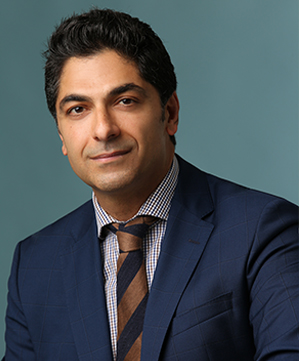Hip Arthroscopy
Dr Kalanie is one of the few surgeons in Sydney with specific sub-specialist training in Hip arthroscopy. After completing his sub-specialist training under the mentorship of A/Prof John O'Donnell in Melbourne he visited a number of international centres to bring back the latest techniques in hip preservation surgery including the following conditions:
- Femoroacetabular impingement
- Fixation of Labral tears
- Hip instability
- Loose bodies/foreign body removal
- Chondral (joint surface) injuries
- Iliopsoas tendinitis/impingement
- Gluteal tendinits/tendinopathies and tears
- Greater trochanteric bursitis
- Tight Iliotibial band
- Snapping hip syndrome
Arthroscopic hip surgery, also referred to as keyhole or surgery, is a procedure in which an arthroscopic camera is inserted into hip to diagnose and treat non-arthritic conditions inside and surrounding the hip joint.
An arthroscope is a small, fibre-optic instrument consisting of a lens, light source, and video camera. The camera projects an image of the inside of the joint onto a large screen monitor allowing us to look for any damage, assess the type of injury, and repair the problem.
Hip arthroscopy is a surgical procedure performed through very small incisions to diagnose and treat various hip conditions including:
- Removal of torn cartilage or bone chips that cause hip pain and immobility.
- Repair a torn labrum: The labrum is a fibrous cartilage ring that seats on the rim of the acetabular socket, sealing and stabilizing the joint.
- Removal of bone spurs or extra bone growths caused by arthritis or an injury.
- Removal of part of the inflamed synovium (lining of the joint) in patients with inflammatory arthritis. This procedure is called a partial synovectomy.
- Repair of fractures or torn ligaments caused by trauma.
- Evaluation and diagnosis of conditions with unexplained pain, swelling, or stiffness in the hip that does not respond to conservative treatment.
Hip arthroscopy is performed under general anaesthesia.
We will make 2 or 3 small incisions about 1/4 inch in length around the hip joint. Through one of the incisions an arthroscope is inserted. Along with it, a sterile solution is pumped into the joint to expand the joint area and create room for us to work.
The larger image on the television monitor allows us to effectively and safely manoeuvre around the joint and treat any underlying condition as necessary.
After the surgery, the incisions are closed and covered with a bandage. The advantages of hip arthroscopy over the traditional open hip surgery includes:
- Smaller incisions
- Minimal trauma to surrounding ligaments, muscles, and tissues
- Less pain
- Faster recovery
- Lower infection rate
- Less scarring
- Earlier mobilization
- Shorter hospital stay
As with any surgery, there are potential risks and complications involved. It is very important that you are informed of these risks before you decide to proceed with hip arthroscopy surgery. Possible risks and complications include:
- Iatrogenic femoral neck fracture
- Avascular necrosis of the femoral head
- Infection at the surgical incision site or in the joint space
- Nerve damage which may cause numbness, tingling, pain (majority of these resolve by 6weeks).
- Excess bleeding into the joint, a condition called hemarthrosis
- Blood clots may form inside the deep veins of the legs which can travel to the lungs (pulmonary embolism).
We may advise you to take certain precautions to promote faster recovery and prevent further complications. These include:
- Taking NSAID medication such as Voltaran, Neurofen, or Celebrex for the first 2-3weeks following surgery.
- Use of crutches to prevent or limit bearing weight on the operated hip for the first week
- Physical therapy exercises may or may not be prescribed depending on your condition and the extent of the underlying pathology.
- Avoiding deep squatting for the first 6 weeks following surgery.
- Eating a healthy diet and avoiding smoking will help in faster healing and recovery
- Avoid activity which involves lifting heavy things or strenuous exercises for first few weeks after surgery
With advances in surgical techniques, arthroscopy plays an important role in diagnosis and treatment of hip diseases. Also, patients can anticipate a quicker recovery with less post-operative complications following hip arthroscopy surgery.
Following the surgery, majority of patients stay in hospital for one night. The hip is often covered with a bulky dressing that can be removed 48hrs following surgery. The surgical incisions are covered with water-proof dressing.
Crutches are used for only a few days post-operatively for comfort. Following your discharge an appointment will be made for you to see Dr Kalanie in 10-12 days following your surgery.
Following your surgery until the time of your first visit, it is best to avoid deep squatting and vigorous activities/sports. Everyday activities of daily living can be carried out as comfort allows.
There can be in some cases significant bruising around the surgical site and even down to upper/mid-thigh. This may take 3-4 weeks to fully resolve.
At any stage if you have any concerns regarding your wound, or increasing pain either at the site of surgery or anywhere in the lower leg contact the St Vincent’s bone and joint clinic for further instructions.




